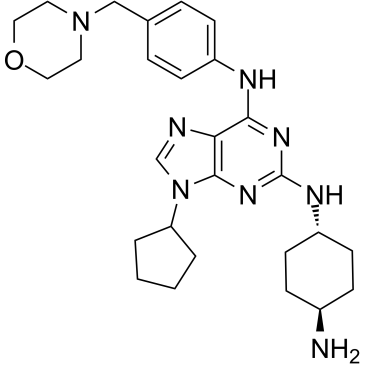| In Vitro: |
FLT3-IN-3 (Compound 7d) inhibits the proliferation of FLT3-ITD positive MV4-11 and MOLM-13 cell lines very effectively at low nanomolar concentrations (GI50 values 2 and 1 nM, respectively)[1]. FLT3-IN-3 (1 nM, 10nM, 100 nM, 1 μM and 10 μM; 72 hours) inhibits the Ba/F3 FLT3-ITD cells with the GI50 of 0.034±0.015 μM, and inhibits the parental Ba/F3 cells with the GI50 value of 1.136±0.389 μM[1]. Concentrations as low as 1 nM are sufficient to block the autophosphorylation of the FLT3 receptor tyrosine kinase at three different tyrosine residues (589, 591, and 842). Moreover, this inhibition suppresses phosphorylation of several downstream targets of FLT3. Notably, FLT3-IN-3 (0.01, 0.1, 1, 10 and 100 nM; 1 hours) abolishes phosphorylation of STAT5 at Y694, which is a direct substrate of the oncogenic FLT3-ITD variant. The second pathway affected is the MAPK cascade: Two key components of this signaling pathway, ERK1/2 (T202/Y204) and MEK1/2 (S217/221), exhibit reduced phosphorylation upon treatment with FLT3-IN-3. FLT3-IN-3 also interfers with PI3K/AKT pathway which is confirmed by reduced phosphorylation of AKT at S473[1]. Cell Proliferation Assay[1] Cell Line: Murine Ba/F3 FLT3-ITD and parental Ba/F3 cells Concentration: 1 nM, 10nM, 100 nM, 1 μM and 10 μM Incubation Time: 72 hours Result: The GI50s for Ba/F3 FLT3-ITD cells and parental Ba/F3 cells are 0.034±0.015 μM and 1.136±0.389 μM, respectively. Western Blot Analysis[1] Cell Line: MV4-11 cells Concentration: 0.01, 0.1, 1, 10 and 100 nM Incubation Time: 1 hours Result: Concentrations as low as 1 nM were sufficient to block the autophosphorylation of the FLT3 receptor tyrosine kinase at three different tyrosine residues (589, 591, and 842). |






















